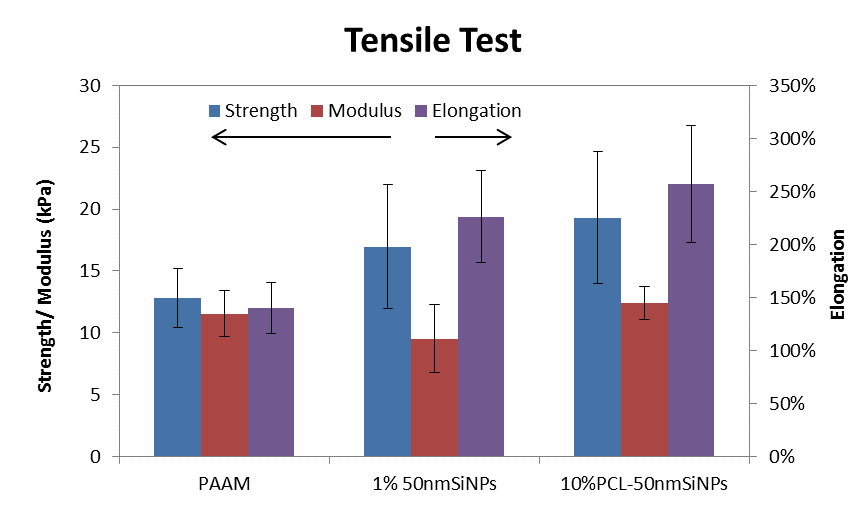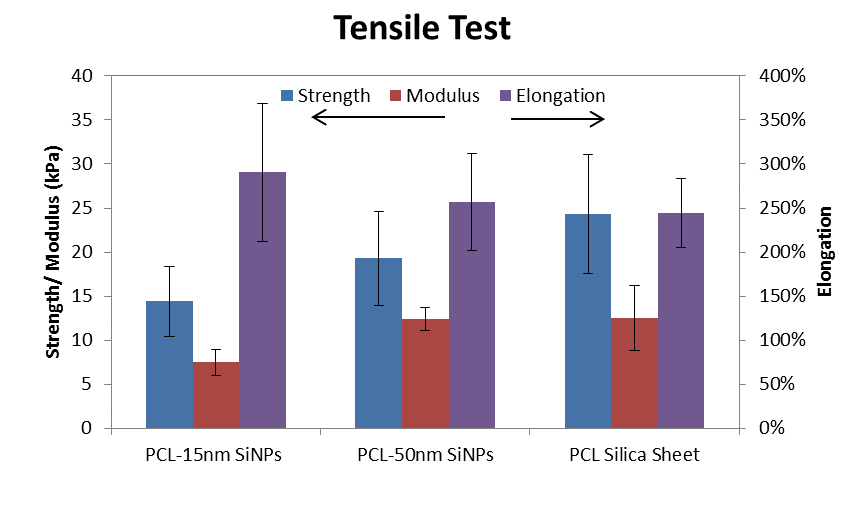58th Annual Report on Research 2013 Under Sponsorship of the ACS Petroleum Research Fund
Reports: ND751620-ND7: Polymer Single Crystals for Nanocomposite Hydrogel
Chrostopher Li, Drexel University
Introduction:
Hydrogels are polymer networks swollen with a large amount of water. As a combination of solid and water component, hydrogels have a high permeability to small molecules and can be responsive to different types of stimuli such as pH, ionic strength, temperature, and light. During the past two decade, significantly efforts have been devoted to hydrogel study for applications such as tissue engineering, drug delivery, and sensing. However, one intrinsic drawback for conventional hydrogel is that they are mechanically weak; typically fail at a tensile stress less than one MPa and stain less than 100%. This significantly limit the application of hydrogel in tissue engineering because many load-bearing biological soft tissues are much stronger and present excellent mechanical performance with high toughness, shock absorbing, low sliding friction and robust contraction. In the project, we aim to demonstrate that polymer single crystal (PSC) hydrogels can be formed with excellent mechanical properties
Results and discussions:
In the second year of the project, we have continued to synthesize various end-functionalized PCL, fabricated PCL PSCs with functional surface, immobilized silica nanoparticles (SiNPs) on the single crystal surface, and synthesized target hydrogel. Three different nanofillers are used as shown in Figure 1.
Figure 1. Schematic of APTMS grafted on (a) 15nm SiNPs, (b) 50nm SiNPs and (c) silica sheet surfaces
PAAM hydrogel and PCL-silica hybrid composite hydrogel were synthesized through in-situ free radical polymerization. AAM monomer, BIS crosslinker, TEMED catalyst, APS initiator and water content were fixed in all the hydrogel samples. Reaction solution with varied filler contents was purged under nitrogen to removed oxygen, which would inhibite the polymerization. The reaction solution was subject to vortex mixing and sonication to ensure the filler uniformly dispersed in the matrix. SiNPs or PCL-silica hybrid filler varied in order to understand the impact of the PAAM/ PCL-silica on mechanical property and swelling behavior.
Tensile Test
Tensile and compression test were used to evaluate the mechanical property of the composite hydrogels. The cylindrical hydrogel sample was cut into a strip with 1mm thick and 6mm long for tensile test. The samples were subject to tensile forces and stress-strain curves were recorded. Multiple tests were conducted for each sample and data deviation may because of the small sample sizes.
Figure 2 compares the modulus, tensile strength and elongation of pure PAAM hydrogel and composite hydrogel. The composite hydrogel contain two important features compared to pure PAAM hydrogel. The composite hydrogel was chemically crossliked with the either SiNP or PCL-Silica filles. The crossliked fillers provided multiple crosslinking points to connect the hydrogel network. The multi-crosslinking sites allowed the polymer chains elongated further before facture. 1% SiNPs composite improved the tensile strength and elongation compared with pure PAAM hydrogel. The SiNPs provided a multifunctional crosslinking point crosslinked with the PAAM hydrogel. The PCL single crystal-templated SiNPs provided 2D orientation for SiNPs assembly. The assembly of SiNPs into 2D structure resulted in mechanical property improvement. The results show that 10% PCL-50nm SiNPs improved the strength by 50.5% and 13.9% while increased the elongation by 83.6% and 13.7% comparing to the pure PAAM hydrogel and the 1% 50nm SiNPs hydrogel.
Figure 2. Comparison of pure PAAM hydrogel and composite hydrogel at strength modulus and elongation.
The effect of PCL single crystal with different sizes of SiNPs on mechanical performance was studied. 15nmSiNPs, 50nm SiNPs and silica sheet structure on tensile stress-strain curves are shown in Figure 1. The SiNPs sizes and structure effects on tensile strength, modulus and elongation were compared and shown in Figure 2. PCL-50nm SiNPs and PCL-silica sheet had higher modulus compared to PCL-15nm SiNPs, as well as the tensile strength. PCL-silica sheet contained the highest tensile strength at 24.31 +/- 6.73 kPa.
Figure 3. Comparison of tensile, strength modulus and elongation with different silica sizes and structures.
Compression test.
Compression test of the as prepared hydrogel samples was used to further understand the mechanical property on the composite hydrogel. Compression test is more closely related to tissue engineering applications. PCL-silica composite hydrogels were compared with pure PAAM and SiNPs hydrogels. Low strain and high strain modulus were determined at 10-20% strain and the high strain linear region respectively. The hydrogel low strain modulus was due to the PAAM polymer chain rearrangement during early stage of compression. The composite improved the low strain modulus of pure PAAM from 16.3 kPa to 26.4-36.5kPa. The composite hydrogel had a greater low strain modulus, which is due to the percolation of the filler.
Figure 4. Modulus of pure PAAM and composite hydrogels
The mechanical property of PCL-SiNPs was compared with the stable PCL-silica sheet structure to evaluate the effect of silica sizes and crosslinked silica sheet. 15nmSiNPs, 50nm SiNPs and silica sheet structure were studied and the results are shown in Figure 5. 50nm SiNP immobilized on to PCL single crystal had higher modulus at low strain, while 15nm SiNP had higher modulus at high strain. During low compression strain, polymer chains rearranged to fill in the free volume in the matrix. For large SiNPs sizes, the average distance between adjacent PCL-SiNPs fillers is smaller and PAAM rearranged and compacted which hardening occurred. On the other hand, polymer chains may still rearrange within small SiNPs size when under the same compression strain.

Figure
5. Comparison of
different SiNPs sizes and structure effect on low strain and high strain
modulus
Summary:
We have successfully synthesized targeted functional polymers, fabricated SiNP-decorated PCL PSC, and synthesized a series of hybrid hydrogels. The PCL-silica composite hydrogel showed an improvement on mechanical property and swelling performance compared to pure PAAM hydrogel. In addition, PCL-silica hydrogel did not fracture during the compression test, while pure PAAM, SiNPs and PCL-diol composite hydrogel did. Higher filler concentration improved the mechanical property of the hydrogel. Silica sizes and structures showed mechanical property behavior differently depended on the molecular arrangements at low and high compression strain. PCL-silica sheet structure resulted the highest mechanical property.
Copyright © 2014 American Chemical Society















